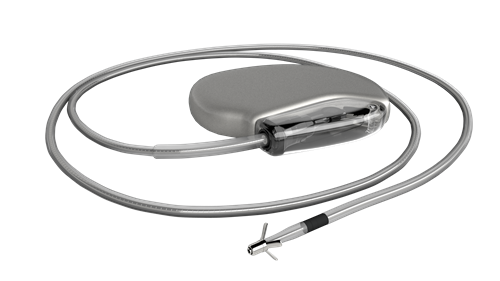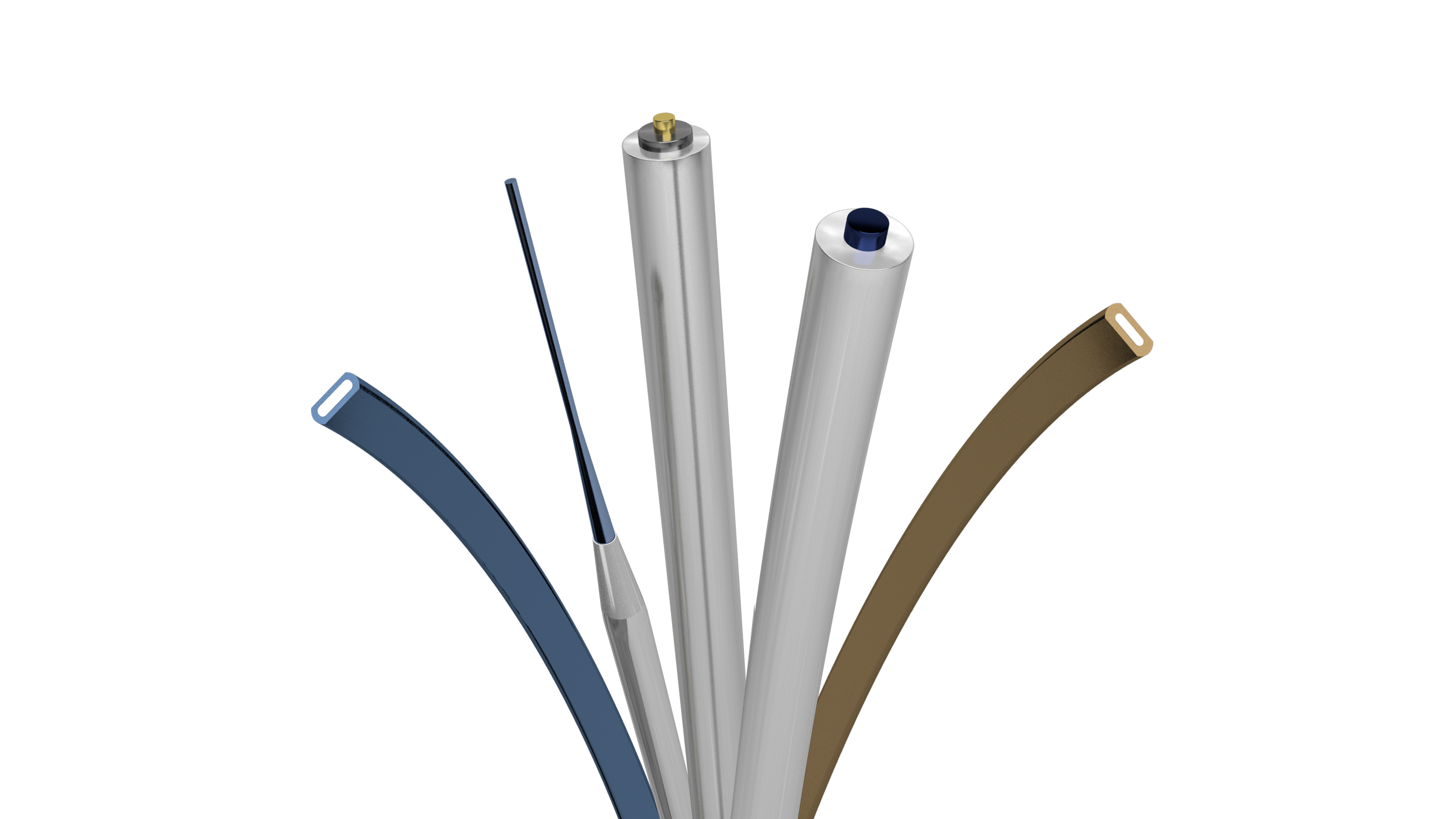Understanding the benefits
Complex applications often require more than any one material can offer. By leveraging the strength and good biocompability of a sheath material, engineers can take full advantage of the desired properties of another material, without expanding the overall diameter. An enormous amount of force is imparted during processing, which forms a mechanical bond between the two materials. This means the material is metallurgically sound - two materials in one.

Typical end uses
DFT® wires find use in a variety of applications, including:
- Aneurysm coils
- LVAD driveline cables
- Neurovascular stents
- Pacing leads
- Retrieval baskets
- Shock coils
- Vascular stents

Design specifications
To build a DFT® wire you select a sheath material based on your desired properties, then pair it with a core material.
The naming convention for DFT® wire follows this logic; you'll see the tube material listed first, following by the DFT® wire designation, and lastly the fill ratio and core material. For example: 35N LT®-DFT®-28%Pt.

Sheath materials:
- 35N LT™ alloy enhanced fatigue life, strength, and corrosion resistance
- FWM™ 1058 alloy high strength and corrosion resistance
- MP35N® alloy high fatigue life, strength, and corrosion resistance
- Nitinol superelastic and shape memory alloy
- Platinum alloys oxidation-corrosion resistance and bonding to platinum pins for assembly
- Platinum oxidation-corrosion resistance and bonding to platinum pins for assembly
- Titanium alloys high strength and corrosion resistance and good biocompability

Core materials:
- Gold electrical conductivity, radiopacity
- Nitinol guidewire tip flexibility and steerability
- Platinum radiopacity, other imaging contrast, moderate electrical conductivity
- Silver electrical conductivity
- Tantalum radiopacity, moderate electrical conductivity
- Titanium-Beta guidewire tip flexibility
Size ranges
DFT® wires can be constructed in sizes ranging 0.017 mm to 3.175 mm [0.0007 in to 0.125 in] or smaller depending on the constituents.
Fill ratios
When designing DFT® wires, the fill ratio refers to the amount of core material in a construction. If the fill ratio is 10%Pt this means that the DFT® wire is 90% sheath material and the platinum core makes up 10% of the construction's cross-sectional area.
Tensile values for 35N LT™ alloy DFT® wire with silver core
DFT® wires are highly customizable, exact mechanical properties vary based on construction, primarily influenced by coldwork percentages and fill ratio. You can use the chart below to compare properties for 35N LT™ alloy DFT® wire with a variety of coldwork percentages and silver fill ratios.
| Cold Work % |
35N LT®-DFT®-25% |
35N LT®-DFT®-28% Ag wire |
35N LT®-DFT®-33% |
35N LT®-DFT®-41% Ag wire |
| 0 | 1091 MPa [158.2 ksi] | 1026 MPa [148.8 ksi] | 1031 MPa [149.6 ksi] | 856 MPa [124.1 ksi] |
| 20 | 1388 MPa [201.3 ksi] | 1318 MPa [191.2 ksi] | 1328 MPa [192.6 ksi] | 1122 MPa [162.8 ksi] |
| 37 | 1555 MPa [225.6 ksi] | 1493 MPa [216.5 ksi] | 1474 MPa [213.8 ksi] | 1143 MPa [165.8 ksi] |
| 50 | 1636 MPa [237.3 ksi] | 1567 MPa [227.3 ksi] | 1549 MPa [224.7 ksi] | 1327 MPa [192.4 ksi] |
| 61 | 1696 MPa [246.0 ksi] | 1627 MPa [236.0 ksi] | 1602 MPa [232.4 ksi] | 1379 MPa [200.0 ksi] |
| 69 | 1770 MPa [256.7 ksi] | 1682 MPa [244.0 ksi] | 1650 MPa [239.3 ksi] | 1423 MPa [206.4 ksi] |
| 75 | 1801 MPa [231.2 ksi] | 1711 MPa [248.1 ksi] | 1671 MPa [242.3 ksi] | 1444 MPa [209.5 ksi] |
| 80 | 1846 MPa [267.8 ksi] | 1755 MPa [254.5 ksi] | 1719 MPa [249.3 ksi] | 1482 MPa [214.9 ksi] |
| 84 | 1903 MPa [276.0 ksi] | 1820 MPa [264.0 ksi] | 1804 MPa [261.6 ksi] | 1496 MPa [217.0 ksi] |
| 87 | 1918 MPa [278.2 ksi] | 1822 MPa [264.3 ksi] | 1808 MPa [262.3 ksi] | 1524 MPa [221.0 ksi] |
| 90 | 1926 MPa [279.3 ksi] | 1822 MPa [264.3 ksi] | 1816 MPa [263.4 ksi] | 1540 MPa [223.3 ksi] |
| 92 | 1944 MPa [281.9 ksi] | 1840 MPa [266.9 ksi] | 1825 MPa [264.7 ksi] | 1601 MPa [232.2 ksi] |
Electrical resistance
Since DFT® wires are commonly used as conductors, you can use the table below to compare 35N LT™ alloy DFT® wire with a silver core to solid 35N LT™ alloy wire.
| Wire size |
35N LT®-DFT®-25% |
35N LT®-DFT®-28% Ag wire |
35N LT®-DFT®-33% Ag wire |
35N LT®-DFT®-41% Ag wire |
Solid 35N LT® wire |
| 0.152 mm [0.006 in] |
3.324 ohm/m [1.013 ohm/ft] |
2.987 ohm/m [0.91 ohm/ft] |
2.555 ohm/m [0.779 ohm/ft] |
2.075 ohm/m [0.632 ohm/ft] |
56.63 ohm/m [17.26 ohm/ft] |
| 0.102 mm [0.004 in] |
7.479 ohm/m [2.280 ohm/ft] |
6.722 ohm/m [2.049 ohm/ft] |
5.748 ohm/m [1.752 ohm/ft] |
4.668 ohm/m [1.423 ohm/ft] |
127.4 ohm/m [38.84 ohm/ft] |
| 0.051 mm [0.002 in] |
29.90 ohm/m [9.113 ohm/ft] |
26.87 ohm/m [8.191 ohm/ft] |
22.99 ohm/m [7.006 ohm/ft] |
18.67 ohm/m [5.691 ohm/ft] |
509.6 ohm/m [155.3 ohm/ft] |
| 0.025 mm [0.001 in] |
119.9 ohm/m [36.53 ohm/ft] |
107.5 ohm/m [32.76 ohm/ft] |
94.36 ohm/m [28.79 ohm/ft] |
74.69 ohm/m [22.77 ohm/ft] |
2039 ohm/m [621.4 ohm/ft] |
Product forms and capabilities
You can further customize your DFT® wire by taking advantage of our additional processing capabilities.
Nitinol DFT® wire
One of the many benefits of using DFT® wire in your application is the ability to utilize Nitinol's superelastic properties combined with an alternate core material, such as platinum or tantalum. One of the primary benefits of using Nitinol DFT® wire is the ability to increase radiopacity of the wire in an X-ray by customizing the fill ratio. Higher fill ratios of radiopaque materials yield better visibility. Nitinol DFT® wire is also available in flat wire form, offering the same thickness as round wire but the larger surface area leads to even greater radiopacity and, as a result, improved visibility. Explore our resource library to learn more about the balance between wire performance and achieving superior radiopacity in X-ray imaging.
Typical applications for Nitinol DFT® wires
Leveraging the ability to increase radiopacity, Nitinol DFT® wires are often used in:
- Aneurysm coils
- Braided stents
- Catheters
- Retrieval baskets
Designing with Nitinol DFT® wire
Nitinol DFT® wires are offered in a number of standard materials and fill ratios to provide maximum design flexibility while offering the convenience of established production processes. The fill ratio of DFT® wire impacts other mechanical properties. Our engineering team can help you determine which materials and fill ratio are best suited for your application. Standard fill ratios include:
- NiTi #1-DFT®-10%Pt
- NiTi #1-DFT®-20%Pt
- NiTi #1-DFT®-30%Pt
- NiTi #1-DFT®-10%Ta
- NiTi #1-DFT®-30%Ta
- NiTi #1-ELI-DFT®-10%Pt
- NiTi #1-ELI-DFT®-20%Pt
- NiTi #1-ELI-DFT®-30%Pt
- NiTi #1-ELI-DFT®-40%Pt
- NiTi #2-DFT®-10%Pt
- NiTi #2-DFT®-20%Pt
- NiTi #2-DFT®-30%Pt
If you'd like to explore options for other combinations, reach out to your Fort Wayne Metals representative.
Ready to help
How can DFT® wire help advance the performance of your applications? Let’s discuss your needs by connecting with one of our technical experts.
Unable to load the form? Click the button below:
